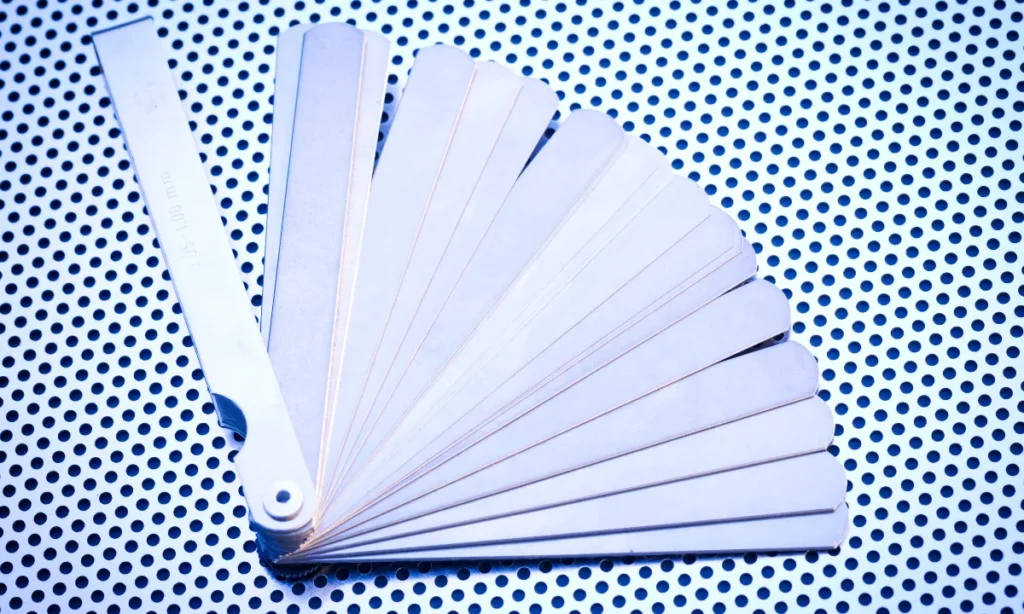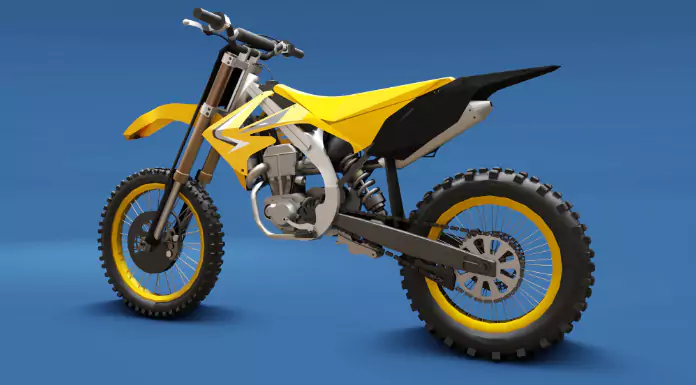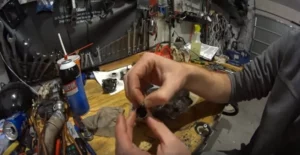The issue of valve clearance adjustment can put a dirt bike rider in trouble, so it’s essential to understand how to check valves on a dirt bike in a broad sense that includes clearance as well.
You might be aware of the significance of bike valve clearance.
If you are unaware of this, you should go read it to yourself so that you may comprehend the significance of dirt bike valve adjustment.
What if, as a rider, you visit a service facility and inquire about the cost of valve adjustment, which prompts you to understand you should also perform the task yourself?
Riders must know when to adjust their valves. I’m sure you’re a committed biker who loves riding. You’re reading this content to learn more.
I guarantee that after reading this post, you will be an excellent dirt bike mechanic.
Don’t take it as something else, but we are talking about your bike only because a rider should have all the knowledge regarding a bike so that if he is riding in a place where no one is there to help, you alone can tackle these problems.
How To Check Valves On A Dirt Bike?
Checking and adjusting the valves on a consistent basis, as well as making a habit of performing routine inspections, is something that is always recommended.
When it comes to high-performance engines that are used frequently on a track, there should be a daily regimen that is followed in order to maintain them.
Valve clearance checks aren’t hard to do, and most dirt bike owners have the skills they need to do them well.
On the other hand, there are numerous hints and secrets that have been revealed by experts that may make this task go more smoothly and produce a satisfactory result.
If you own a dirt bike, a street bike, or any other type of bike that is powered by a four-stroke engine, then you should have received your owner’s manual by now.
This manual has the best instructions for how to do a valve clearance inspection on an engine.
And it’s important for every rider to be aware of the signs that indicate tight valves on a dirt bike or a dirt bike.
The inspection interval may vary from one brand to another, depending on the use of it; for example, it may be specified in terms of a certain number of hours or it may be calibrated in relation to the distance traveled.
Because it’s important to make sure the engine works well for a long time, all dirt bike owners are required to check the clearance at set times.
Tools Required for the Inspection of Dirt Bike Valve
- Feeler gauges
- Clean rags or towels
- Screwdrivers
- Vernier Caliper
- Metric wrenches
- Metric sockets
Other additional tools which are Required:
- Owners manual
- Allen keys
- Tie-wire
- Magnet
1. Feeler gauges

A feeler gauge is a measuring instrument that may be used with the hands to measure the distance between two objects. It is also known as a gap gauge.
It is made up of a number of overlapping and folding metal strips, which can also be referred to as blades or leaves, and each strip has a different thickness that is predetermined.
The unit of measurement can be taken in millimeters, but it can also be taken in inches, and both of those options are clustered together in the middle of each strip. I
t is a minimum of 0.02 millimeters in order for it to fit into the smallest space between two sheets of metal or two metals for any things that have this much gap between them.
The feeler gauge has the capacity to measure dimensions as small as 0.02 millimeters, which is equivalent to 0.0008 inches, and as large as 5.08 millimeters, which is equivalent to 0.02 inches.
When you purchase this measuring gauge and instrument, you will have measurements as well as Specs rates and on a strip of 8, and you will also have a handbook for this product.
A filler gauge is a little bit different from other measuring devices because the gap can be seen visually, and the metal strips of the feeler gauges are inserted into the gap until it is completely filled. If it has filled the complete space, then you can calculate the exact gap between any dimensions.
2. Clean rags
To wipe things down with, rags are an essential component of any cleaning routine.
If it is used appropriately, it has the potential to be one of the least harmful to the natural world. After cleaning, there is no need to leave any lint behind.
While you are using it, you need to be careful because, if it is not used properly, it has the potential to become an unpleasant, odorous mess.
To ensure that the valves are clean, we can make use of cleaning rags while we check the valves.
3. Screwdrivers
A screwdriver is defined as a tool that is operated by the hands turning motion which is a specially designed tip that can be inserted in the screws head.
The tip of a screwdriver is specifically designed to fit in the head of a screw. There are a variety of tip designs available, each one optimized for a specific kind of application and used for the application of assembly.
Standard screwdrivers, which are also known as flat straight or shared tips, are by far the most common type of screwdriver. The handle of the screwdriver can be made of either plastic or wood.
The perfect grip is provided by the rubberized cover that comes on many screwdrivers today.
A screwdriver is an essential tool that must be utilized at all times throughout the inspection and maintenance of the valve.
4. Vernier Caliper
The Vernier calliper is widely considered to be one of the most accurate measuring tools. The reading error is 1/20 of a millimeter, which is equal to 0.05 millimeters, and the tolerance is 0.02 millimeters.
With the help of this instrument, one can perform mechanical interpolation in order to obtain an accurate reading of a measurement that is located between two graduated markings on a linear scale.
Pierre Vernier, a French scientist, was the brains behind the invention of this instrument, which is utilized for the making of accurate linear measurements. He had a citizenship in France.
There are two graduated scales in a vernier scale: the first is the main scale, which is analogous to a ruler; the second is the vernier scale, which slides parallel to the main scale and enables readings to be made to a fraction of a division on the main scale.
The main scale and the vernier scale are both analogous to rulers. The scientific laboratory and manufacturing industries both make extensive use of Vernier callipers for quality control and quality analysis purposes, respectively.
5. Metric wrenches
Tools that work with fasteners, such as a metric wrench, are of critical significance. Wrenches are an item that are required in almost every home in order to repair the many sorts of devices.
The vast majority of people made adjustments to their household appliances, autos, or bicycles using wrenches. These adjustments typically involve nuts and bolts.
To qualify as a cyclist, you are required to have a wrench. The wrench is available in a variety of sizes and contours.
6. Metric sockets
The nominal length of the fastener must be a round number of millimeters, such as 8, 10, or 15 mm, for the metric socket wrench to be able to fit it. When utilizing this metric socket, a number of ranges can be measured precisely at the nominal dimension. Clearances and tolerances are critical in the manufacturing industries.
How To Check Valves on A Dirt Bike – Complete Step by Step Method
In order to properly inspect the valve, we will need to uncover a portion of the engine. Regarding the inspection, you will need to open the engine, so it is to your advantage if it is spotless all the way through.
Before continuing with the process, you need to give the engine a comprehensive cleaning because there is a possibility that dirt and debris will get inside.
First things first, you have to clean the cylinder as well as the area around it.
1. Remove cylinder head-cover
After cleaning the cylinder head, it is now time to remove the cover from the cylinder head. Racks that have previously been cleaned can be utilized for the cleaning process, as was stated earlier on this page.
After this, you will need to take out your seat, your fuel tank, and any other components that are still attached.
It is possible to do so by following the instructions provided in your service manual, which contains adequate direction for the removal of any parts or components that must be removed in order to expose your engine.
One thing that you need to keep in mind is that when you are removing the cover from the cylinder head, you need to be extremely cautious and aware so that you do not drop anything inside the cylinder head.
This is something that you need to make sure you remember to do.
2. Position the Valvetrain
Following that, you will need to position the valve train in such a way that the clearances can be examined.
Given that the piston is at TDC, which means the top dead centre on the compression stroke, there is a specified method of setting the valve train that can be found in service manuals.
When you set the valve train to the specified position, it ensures that the cam is in a circle, and in that position, neither the intake nor the exhaust valves are open. This happens because the valve train is in the specified position.
The base circle of the cam is what moves in a circular motion, and this circle does not contribute in any way to the valve lift.
If you are not familiar with the user manuals, which is the method that is most recommended for setting the piston position and engine stroke when the engine is being assembled, then it is not necessary for you to do so, especially when you are working on the engine that is being rebuilt.
You can finish the inspection of valve clearance even if the cylinder head is removed from the engine.
By positioning the cam lobe opposite to the lifter brackets, you can ensure that the clearance measurements are taken with the cam on its base circle.
The engine should be set to TDC on its compression stroke using the service manual that comes with the manufacturing company. This manual contains sufficient instructions for doing so. In addition, engines feature a meeting alignment signature on both the crankshaft and the engine case, in addition to the cylinder head and cam gear.
Because these reference points are used to correctly set the cam timing after any valve clearance adjustment has been successfully made, it is imperative that you learn how to use them as marks and have a solid understanding of how to do so.
3. Measure the Clearance
Feeler gauges can be used to measure the clearance after the cam valve has been correctly positioned. Feeler gauge measurements are extremely important due to the fact that taking them requires a trained professional due to the constrained surrounding geometry.
A person who lacks experience is more likely to get inconsistent results from his measurements.
In order to obtain data that is precise and perfect for measurement, it is necessary that the gauge be inserted between the lifter bucket and the cam in a manner that is as close to parallel as is possible. In order to keep the parallel entry, you will need to bend the feeler gauge in the required manner.
This will allow the feeler gauge’s tip to fit easily inside the space between the cam and the lifter bucket.
Since gauge measurements are derived from hand measurements, also known as a “feel,” it is generally agreed that these measurements cannot be considered objective.
The feeler gauges should be passed between the lifter bucket and the cam with the slide drag engaged in order to obtain the most accurate measurements possible of the valve clearance.
When the feeler easily passes through or when it must be forced through, the material should be considered thin or thick, depending on the situation. When this occurs, you should try using other gauges as well. If you are between sizes, the average of the two readings should be used to determine the valve clearance.
4. Compare the Recorded Clearances with Standard Specification
Following the completion of the measurement of the intake and exhaust valve clearances, their respective readings should be compared with the standard specification that is mentioned in the user’s manual.
If the valve clearances are within the recommended specification given by the manufacturer, there is no need for any additional work to be done, and it is not recommended that it be done either. If the clearances are greater than the specification that is listed in the user’s manual, then the next step requires you to determine what adjustment needs to be made in order for the machine to function properly.
In order to finish this, you need to get the measurements of the current valve shim thickness, and you also need to disassemble the cylinder head so that the shims can be removed and measured.
5. Remove the Cam Cap, Cams and Lifter jackets
Now you will need to refer to the user handbook for more instructions on how to loosen the cam chain, remove the camp cap, cams, and lifter jackets.
When you are taking off the cam cap, you need to make sure that you follow any procedure that is mentioned in the user’s manual for taking it off or tensioning it.
You are free to use a piece of wire to secure the cam chain to the cylinder head. If the chain for some reason falls into the chaincase, you can use a permanent magnet to retrieve it.
A pen magnet or a valve lapping tool can be used to remove the lifter bucket from its housing. When removing the lifter bucket from the valve, it is imperative that extreme caution be exercised.
When taking off the lifter bucket, you have to be very careful with the valve shim so that it doesn’t stick. It’s not uncommon for shims to get stuck underneath the lifter buckets.
When the engine is running, the lifter buckets will fit into their respective bores. Disassembly is something that most people are accustomed to doing, but putting something back together in its original place can be challenging.
You can make it less difficult by drawing a diagram for disturbing and keeping it in sequence; this will be of great assistance to you when you do it again and when you are putting it all together.
5. Remove the Valve shims
After that, take the remaining valve shims and remove them from the cylinder head. When you take out the shims from the valves, measure the thickness of the shims as well as the diameter of the shims.
Find the required shim thickness
For determining the shim thickness there is the formula:
Req. Shim Thickness = Measured Clearance - Specified Clearance + Old Clearance
The phase of the procedure in which you calculate the necessary Shim thickness in order to adjust the valve has now arrived. Who among the global companies sells valve shims? There are also shim kits available on the aftermarket, and these kits come with a range of different sized shims.
Which of the multinational businesses offers valve shims for sale to customers?
You need to first calculate the diameter of the shim that you need to use before going out and getting it. This should be done before you go out and buy the shim.
Diameters can varied from one another due to the fact that many manufacturers offer circumferences in a variety of sizes.
Valve Shim Diameters
- KTM – 8.90
- KTM – 10.00
- Japanese – 7.48
- Japanese – 9.48
When figuring out how thick the shim needs to be, you should start with the assumption that you will need to move toward the higher end of the prescribed clearance range.
6. Adjust valve by Inserting the required shim
This is something that is always recommended by specialists due to the fact that valve clearance typically decreases over time.
Diameters of 0.02 millimeters and larger show how useful the shims are, which will also change the new clearances that are possible.
Once you know how thick the shims need to be, you can finally start putting the valve train back together.
7. Lubricate and install the valve shim
In order to use engine oil, the valve shims need to be lubricated first, and then they need to be installed very carefully.
When you are inserting the lifter bucket into their respective bores, you need to make sure that buckets bottom on the shims and are properly adjusted. You are required to lubricate the lifter brackets also before its installation.
If it were to happen that the bucket would come back up while the installation was taking place, the shim would sometimes get stuck to it and become displaced. If the shim is not installed correctly, then there is a risk that the engine will sustain significant damage between the valve and the lifter bucket.
8. Set the cam valve and its timing
After that, adjust the cam and the timing of the cam, and position the crankshaft in the ideal location.
At this point, you should pull the chain and tighten it from the crankshaft. Check that the cam gear is installed in the correct orientation, and make sure that the chain is wrapped around it.
Check that all of the components and parts are aligned correctly, and make sure that the cam bearing is properly lubricated.
When installing the cam cap, make sure to refer to the user manual and keep the torque specifications and installation sequences exactly as they are written.
There should not be any deviation that could bring about a fitment issue, which would cause cam wear.
After the cams have been secured, use the feeler gauges to determine whether or not the clearance exceeds the tolerance.
The deviation should be kept, and if there is anything that is not according to the specifications, then the error should be fixed before moving on to the next step.
9. Tension the cam chain
Now you have to proceed to tension the cam chain. Follow the manual’s guide to complete this. When the tension is perfect, rotate the engine at least 5 to 6 full revolutions. This will correct the chain position.
That will also confirm the engine has been timed correctly. Fix the position of the piston on the compression stroke and check the timing features on the crank and cam remaining in the specification.
Finally, finish the process by reinstalling the cylinder head cover carefully. And per specification, tighten the bolt. Hurray! Now you are ready to ride.
Conclusion
How to check valves on a dirt bike can be a difficult question to ask a beginner, but for the experienced rider, it may be a daily routine. Valve inspection on a dirt bike is almost a habit if you are serious about the sport.
As a result, maintaining a bike’s performance in order to increase efficiency is a critical task. Hence, in this post, we have talked about dirt bike valve inspection so that you can also be a master in this activity.
Sources: Thumper talk (how to check and adjust valve clearance), How stuff works Screwdriver






